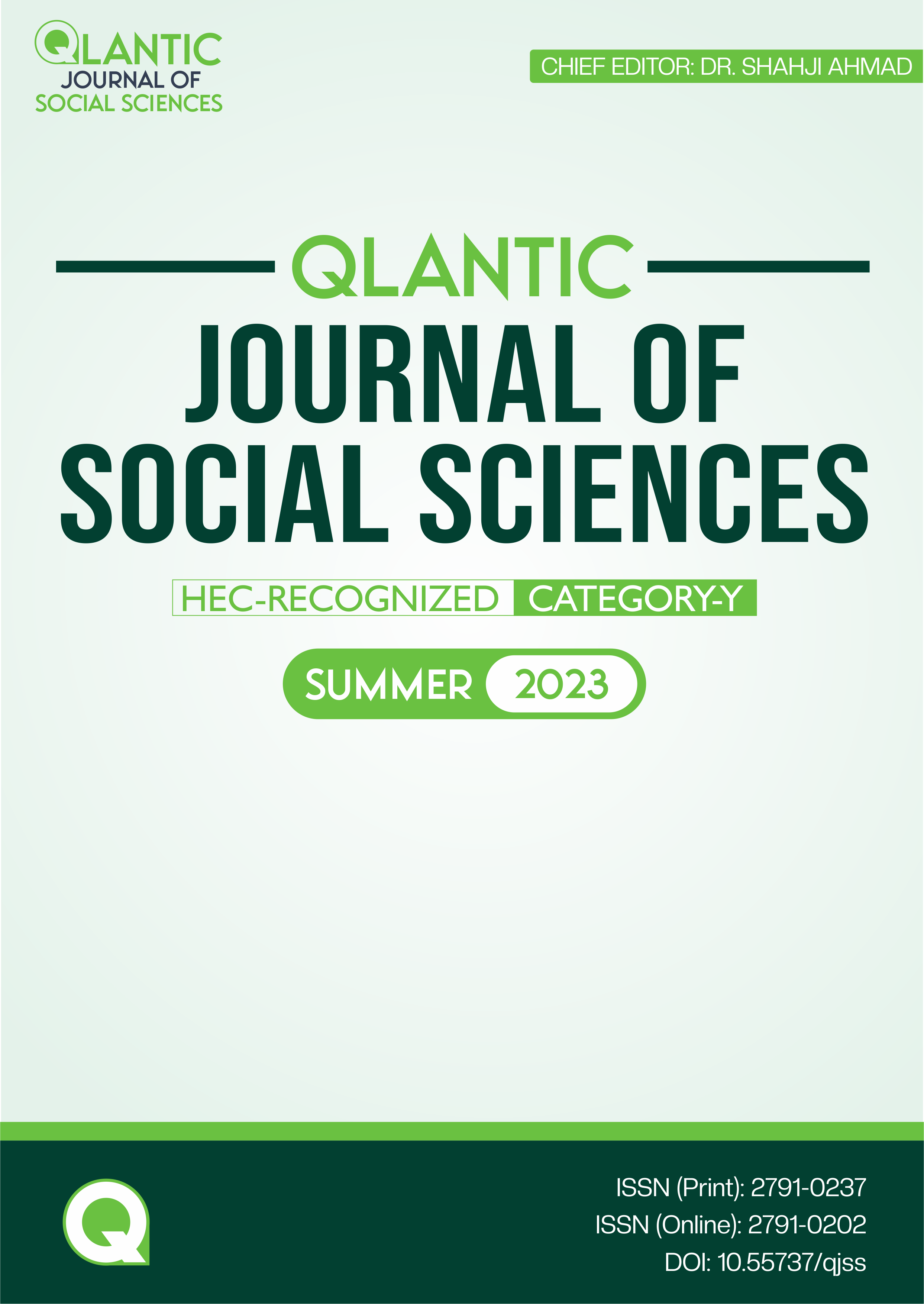Effect of Principals' Strategic Planning on Students' Academic Learning and Managerial Capability at College Level
DOI:
https://doi.org/10.55737/qjss.807890139Keywords:
Principals’ Strategic Planning, Students, Education, Academic Learning, Managerial Capability, College LevelAbstract
The objectives of the study were to study the relationship between Principals’ strategic planning and students’ academic learning, to explore the key components of Principals’ strategic planning, to identify the factors that affect principals’ strategic planning on students’ academic learning and managerial capability at the college level, to recommend certain measures to promote the performance of principals. The study was survey and descriptive in nature. Quantitative as well as qualitative (QUAN-qual) methods were used. The explanatory sequential technique was adopted. This study emphasized the role of a college principal at a public sector institution. The population of the study comprised heads of private-area colleges, lecturers at open-area colleges, and pupils studying public-sector colleges. The simple random sampling technique was used. Following is a list of the most important aspects of the interview for principals: planning, organizing, staffing, coordinating, and budgeting, among other related responsibilities. The study concluded that the majority of respondents agreed with the declaration. Collectively, the majority agreed that the principal plans for the learning activities of college students. The training programs must be arranged for the college teachers to keep the staff updated. The college Principal must provide a way for all the workforce fellows to shadow all the rubrics & rulings.
References
Andleeb, N., Kamran, M., & Akram, H. (2022). Examination of the Demographic Variables in Promoting Creativity in Pakistan: A Follow-Up Study. International Journal of Business and Management Sciences, 3(2), 35-47. https://www.ijbms.org/index.php/ijbms/article/view/190
Arooj, T., Parveen, S., Iqbal, M., & Kamran, M. (2021). Proposing Creativity Inclusion in the Primary Education of Pakistan: Analysis of Educational Policy Documents and Curricula of Multiple Countries to Draw the Framework. Turkish Online Journal of Qualitative Inquiry, 12(9), 3088-3095. https://www.tojqi.net/index.php/journal/article/view/6203
Aslam, M. A. M., Muhammad, J. M. Z. D. J., NaeemUllah, N. D., & Kamran, M. K. M. (2023). Identification of Teachers' Academic Challenges and Guidelines for Promoting Academic Quality at Workers’ Welfare Schools in Punjab, Pakistan. PERODICALS OF SOCIAL SCIENCES, 3(1), 273-290. https://psocialsciences.com/wp-content/uploads/22.-Identification-of-Teachers-Academic-Challenges-and-Guidelines-for-Promoting-Academic-Quality-at-Workers-Welfare-Schools-in-Punjab-Pakistan.pdf
Beames, J. R., Lingam, R., Boydell, K., Calear, A. L., Torok, M., Maston, K., Zbukvic, I., Huckvale, K., Batterham, P. J., Christensen, H., & Werner-Seidler, A. (2021). Protocol for the process evaluation of a complex intervention delivered in schools to prevent adolescent depression: the Future Proofing Study. BMJ Open, 11(1), e042133. https://doi.org/10.1136/bmjopen-2020-042133
Bigland, C., Evans, D., Bolden, R., & Rae, M. (2020). Systems leadership in practice: thematic insights from three public health case studies. BMC Public Health, 20(1), 1-14. https://doi.org/10.1186/s12889-020-09641-1
Hilton, J. (2016). "Open educational resources and college textbook choices: A review of research on efficacy and perceptions." Educational technology research and development 64(4), 573-590. https://doi.org/10.1007/s11423-016-9434-9
Kamran, M., Arooj, T., & Amjid, M. (2021a). Examination Of The Perception Level Of Teachers About The Promoters To Creativity In Pakistan: Seeing Through The Demographic Differences Of Gender, Area And Marital Status. Pakistan Journal of Humanities and Social Sciences Research, 4(2), 77-88. https://doi.org/10.37605/pjhssr.v4i2.182
Kamran, M., Hayat, F., & Khan, M. (2021b). Shaping A Contextualized Theory For The Definitions Of Creativity: A Case Of Pakistani Secondary Science Teachers. PalArch's Journal of Archaeology of Egypt/Egyptology, 18(10), 2306-2317. https://archives.palarch.nl/index.php/jae/article/view/10176
Kamran, M., Shah, S. A., & Rao, C. (2017). Secondary Science Teachers’ views About The Placement Of Creativity In Secondary Classes: A Qualitative Study. European Journal of Education Studies, 3(8), 838-851. https://doi.org/10.5281/zenodo.888749
Kamran, M., Zafar, N., & Bashir, M. (2022). Teachers’ Creativity Promotion with Respect to Teaching Experience, Teaching Level, Sector and Gender vise Schooling System, and Subject Teachers Teach: Evidence from a Broader Pakistani Context. Journal of Peace, Development and Communication, 6(3), 30–51. https://doi.org/10.36968/JPDC-V06-I03-03
Liu, S., & Hallinger, P. (2018). Principal instructional leadership, teacher self-efficacy, and teacher professional learning in China: Testing a mediated-effects model. Educational administration quarterly, 54(4), 501-528. https://doi.org/10.1177/0013161x18769048
O'Keefe, L. A., & Gunder, et al. (2021). "Stronger Together: A Briefing of Findings and Recommendations from the 2020 HBCU Action Nation Town Hall." Online Learning Consortium. HTTPS://ONLINELEARNINGCONSORTIUM.ORG/READ/STRONGER-TOGETHER/
Powell, M. A., & Graham, A. et al. (2018). "Wellbeing in schools: what do students tell us?" The Australian Educational Researcher 45, 515-531. https://doi.org/10.1007/s13384-018-0273-z
Saleem, A., Deeba, F., & Naz, F. L. (2020). Role of Instructional Leadership on Teachers’ Performance at College Level. Pakistan Social Sciences Review, 4(1), 1058-1071 https://pssr.org.pk/issues/v4/1/role-of-instructional-leadership-on-teachers-performance-at-college-level.pdf
Wang, M.-T., & Degol, J. L. (2016). "School climate: A review of the construct, measurement, and impact on student outcomes." Educational psychology review 28(2), 315-352. https://doi.org/10.1007/s10648-015-9319-1
Widtayakornbundit, S. (2019). A study of leadership in educational institutions under the dual system of private vocational system. Kasetsart Journal of Social Sciences, 42(3), 527–534. https://so04.tci-thaijo.org/index.php/kjss/article/view/253472




